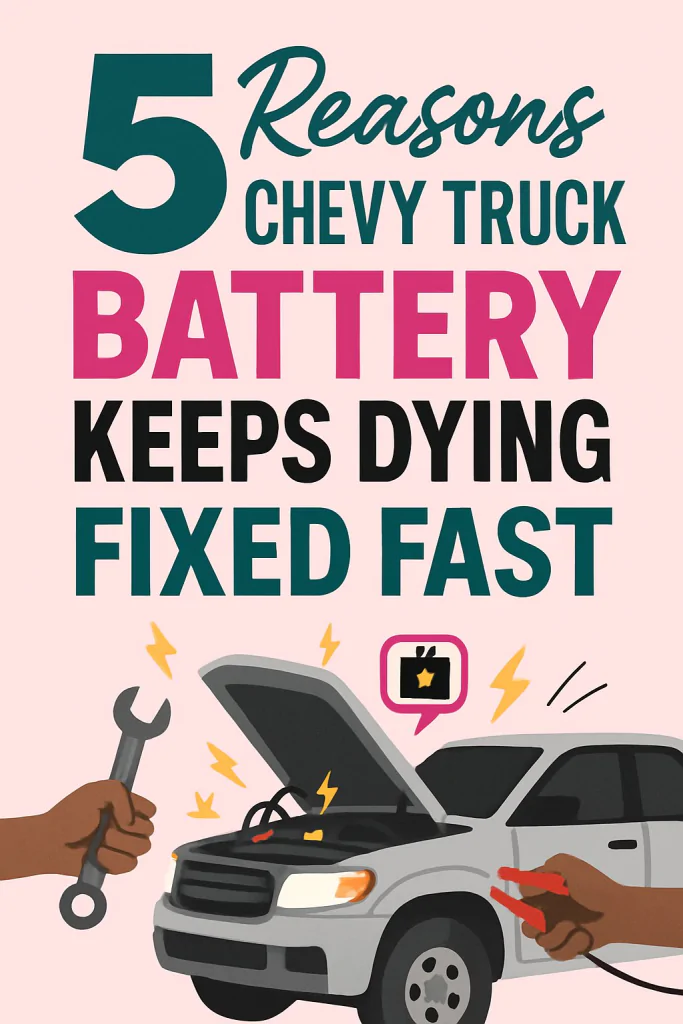Chevy Truck Battery Keeps Dying: Causes, Fixes, and Prevention

Nothing’s more frustrating than hopping into your Chevy truck, turning the key, and… click click click. Dead battery. Again.
If your Chevy truck battery keeps dying, you’re not alone. I’ve owned a Silverado that seemed to eat batteries for breakfast, and I know firsthand how annoying it is when your truck refuses to hold a charge. Whether you’re late for work, stranded at the grocery store, or just tired of jump-starting every other week, the struggle is real.
The good news? With the right approach, you can figure out why your battery keeps draining and fix it without throwing money at random parts. Let’s break it all down—step by step, no fluff, just real-world solutions.
Why Does My Chevy Truck Battery Keep Dying?
There’s no one-size-fits-all answer. Batteries drain for a mix of electrical, mechanical, and environmental reasons. Here are the most common culprits:
1. Old or Weak Battery
- Car batteries usually last 3–5 years.
- If yours is older, it may not hold a full charge anymore.
- Cold weather makes weak batteries die even faster.
2. Parasitic Drain
- Electrical components keep pulling power when the truck is off.
- Common offenders: dome lights, aftermarket radios, alarm systems, or even a faulty module.
3. Alternator Issues
- The alternator charges the battery while driving.
- If it’s weak or failing, the battery never gets fully recharged.
4. Loose or Corroded Connections
- Dirty terminals block proper charging.
- Loose cables can cause intermittent starting issues.
5. Short Driving Habits
- Constant short trips don’t give the alternator enough time to recharge the battery.
- This is especially common if you only use your truck for local errands.
Signs It’s a Battery Problem (Not Something Else)
How do you know if the battery itself is the issue? Look for these signs:
- Slow cranking when starting
- Clicking noise when turning the key
- Battery light flickers on the dash
- Visible swelling or corrosion on the battery case
- Battery older than 4 years
👉 Pro Tip: Most auto parts stores will test your battery and charging system for free. Do this first before guessing.
Step-by-Step Diagnosis
Let’s play detective. Here’s how to figure out what’s killing your battery.
Step 1: Inspect the Battery
- Check the manufacture date.
- Look for swelling, cracks, or leaks.
- Clean corrosion with a baking soda/water mix.
Step 2: Check the Alternator
- Start the truck and measure voltage at the battery with a multimeter.
- Normal range: 13.8–14.5 volts.
- If it’s lower, your alternator may not be charging correctly.
Step 3: Look for Parasitic Drain
- Disconnect the negative battery cable.
- Hook up a multimeter in amp mode between the cable and post.
- Anything over 50 milliamps draw is too high.
- Pull fuses one by one until the draw drops—that’s your culprit circuit.
Step 4: Check the Grounds and Cables
- Inspect all major grounds from battery to frame and engine block.
- Tighten loose connections and replace corroded cables.
Common Fixes for Chevy Truck Battery Drain
Alright, once you’ve found the culprit, here’s how to fix it.
1. Replace the Battery
- If it’s weak, old, or damaged, swap it.
- Cost: $120–$200
- DIY Difficulty: Easy (10 minutes with basic tools)
2. Fix Alternator Problems
- If your alternator isn’t charging properly, replace it.
- Cost: $200–$400 (parts), $400–$700 (shop)
- DIY Difficulty: Medium (you’ll need basic tools and some patience)
3. Clean and Secure Connections
- Remove corrosion with a wire brush.
- Apply dielectric grease to prevent future buildup.
- Tighten all cable ends.
- Cost: $10–$20
- DIY Difficulty: Easy
4. Repair Parasitic Drain
- If you found the drain circuit, fix or replace the offending part.
- Could be a stuck relay, faulty radio, or bad module.
- Cost: $20–$200 depending on part
- DIY Difficulty: Varies
5. Upgrade Driving Habits
- Take the truck on a longer drive once a week.
- Consider using a trickle charger if it mostly sits.
Chevy-Specific Quirks That Kill Batteries
Chevy trucks—especially Silverados—have some known electrical gremlins. Here are a few worth checking:
Bad Ground Wires
- Silverado trucks are notorious for weak chassis grounds.
- Adding an extra ground strap often fixes mystery drains.
Sticking Relays
- The fuel pump relay is a common parasitic draw culprit.
- It can keep running after the truck is off.
BCM (Body Control Module) Issues
- The BCM controls interior electronics.
- If it glitches, it may leave lights or systems powered on.
Aftermarket Mods
- Lift kits, stereos, LED light bars—fun stuff, but if not wired properly, they can drain the battery overnight.
Cost Breakdown
Here’s a quick money guide so you know what you’re getting into:
| Fix | DIY Cost | Shop Cost |
|---|---|---|
| New Battery | $120–$200 | $200–$350 |
| Alternator Replacement | $200–$400 | $400–$700 |
| Battery Cables/Terminals | $10–$50 | $100–$200 |
| Parasitic Drain Repair | $20–$200 | $200–$600 |
| Ground Strap Upgrade | $15–$40 | $80–$150 |
👉 Notice how some fixes are dirt cheap? Don’t let a shop scare you into thinking it’s always a $700 repair.
Can You Keep Driving with a Dying Battery?
Technically yes, but it’s risky.
- You may get stranded when it finally dies.
- A weak battery can stress the alternator, shortening its life.
- Electronics like ABS, radio, or lights may behave erratically.
IMO, if your Chevy truck battery keeps dying, fix it sooner rather than later. It’s way cheaper (and less embarrassing) than begging strangers for jump-starts in parking lots. 😅
How to Prevent Future Battery Issues
Nobody wants a repeat performance. Here’s how to keep your Chevy battery happy:
- Replace batteries every 4–5 years.
- Clean terminals every 6 months.
- Don’t let aftermarket accessories run directly to the battery—use relays.
- Use a battery maintainer if the truck sits for weeks.
- Upgrade grounds if you own a Silverado (seriously, it helps).
Conclusion
If your Chevy truck battery keeps dying, don’t panic. It usually boils down to one of five things:
- Old battery
- Weak alternator
- Parasitic drain
- Bad connections
- Chevy-specific quirks like grounds or relays
The key is to diagnose before replacing parts. Start with the simple stuff (gas cap for EVAP, battery here 😉), then move deeper if needed.
When my Silverado kept leaving me stranded, it turned out to be nothing more than a loose ground strap. Ten bucks later, no more dead mornings. Sometimes the fix really is that simple.
So grab your multimeter, take your time, and track down the culprit. Because nothing feels better than turning the key, hearing your Chevy roar to life, and knowing you solved it yourself.






